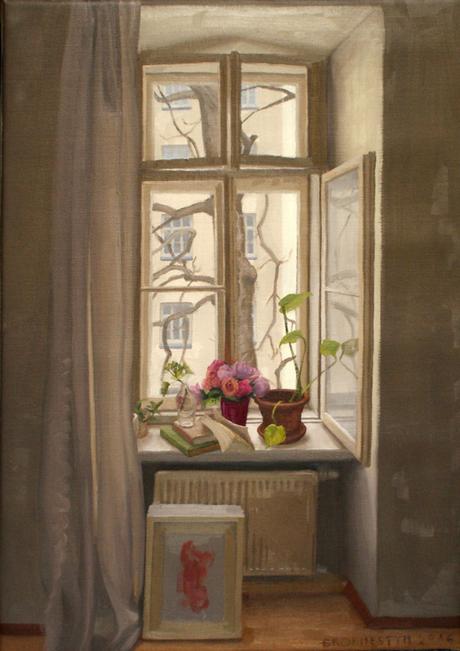
Pantzergasse, Winter (c) 2016 Samantha Groenestyn (oil on linen)
When I paint, I am ever torn between two conflicting intentions. I am driven towards what we might call naturalism, the honest representation of things as they appear to me in the natural world, but I am constantly diverted by the lusciousness of paint and by my own systems of manipulating that substance that I have cobbled together from things learned and things discovered. As I stand before my canvas, I anticipate how convincingly naturalistic my finished painting will be, but my brain immediately sets to work in undermining that intention by ordering what I see into a complex system of relationships. In short, I cannot paint what I see, because paint promises the possibility of depicting things in more suggestive ways, and because it also imposes certain physical limits, within which I try to condense my understanding of what I see.
This leads me to survey my work with dismay: my paintings positively glow with an unearthly artificiality. The objects and people that populate them are glaringly constructed, and set under a contrived light, though observed from life. I see a more naturalistic painting and I despair at my own artifice.

But I do not despair for long, because I quickly turn to questioning naturalism itself. And on this point I am persuaded by two claims from Ernst Gombrich. In Art and Illusion, he argues that ‘all representations are grounded on schemata which the artist learns to use’ (Gombrich, 1959: 264). And very quickly thereafter, he points out that the very ‘stimulus … is of infinite ambiguity’ (Gombrich, 1959: 264-5). ‘Naturalism’ is something of a misleading idea because it disguises how variable nature and our own visual experience of it is. At the very least, we might demand that the term be broad enough to admit many types of representation that aim at capturing something honest about the natural world. But one breed of naturalism tends to prevail as the most correct or ‘realistic’ in our modern eyes: the kind that makes us mistake paintings for photographs. We have permitted photography to become the unerring benchmark for ‘reality’ in the visual realm. Photography conditions our experience of sight.
Photography, it must be pointed out (for it is often forgotten), lets us down on many accounts. It fails to match the rich spectrum of colours our eye is able to enjoy, or to exhibit such a fine sensibility towards tonal gradations; it is not binocular, and does not have the luxury of flitting around a scene just as our ever-active eyes devour it, composing a view out of collected fragments. A photograph, an arbitrary slice of time, is often precisely the ‘wrong’ slice that we feel does not represent us, caught blinking or speaking or chewing. Focal lengths distort perspective, bending our physical constitution. As a measure for ‘reality,’ photography makes a fairly poor standard, and probably a worse one for coming so close and deserting us when we least expect it. If we are ignorant of its shortcomings, our conception of ‘reality’ is itself swallowed up by photography.
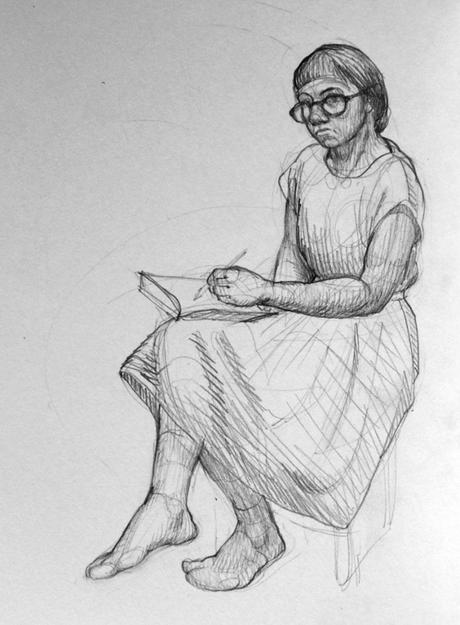
I do not want to attempt to define reality, for this is an immense task I should not like to claim responsibility for. But I want to suggest that our own vision is more remarkable than photography. When we judge the success of any representation, painted or otherwise, we might remark how near to our own complex visual experience it comes. And we might bear in mind that sight is one thing, and representations are quite another, and the camera, let us not forget, offers but another mode of representation.
And as Gombrich argues, every representation is founded on schemata. Painting that orients itself via photography imports the schemata of photography into painting. The schemata of photography are not simply felt in the work of artists who copy photographs. They permeate the work of many who work ‘from life,’ who directly observe the world, but whose strategy in painting is to organize what they see just as a camera would. They crush dark tones together, even ones that are not actually shadows. They blanch and flatten light areas, uninterested in the undulating forms of the voluminous object before them. They impose a high tonal contrast—very dark against very light—to great dramatic effect, but utterly without nuance. Softness and blur takes on the uniform flavor of the lens, unlike the scattered haze that bleary or myopic eyes encounter. But when refining a surface they disguise lack of structural understanding with microscopic precision: paying painful attention to the blemishes and creases and stray hairs that are prized as ‘detail.’ ‘The artist’s starting point will determine the final product,’ cautions Gombrich (1959: 92); ‘The schema on which a representation is based will continue to show through the ultimate elaboration.’
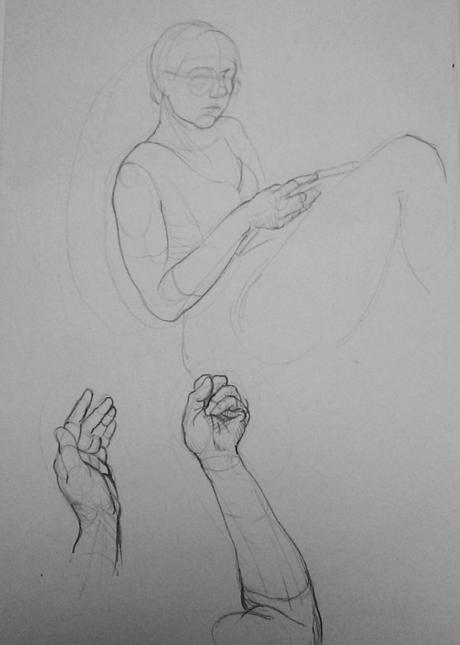
Put differently: choose your influences, guide your aesthetic. A painter is constantly growing and adjusting her schemata according to what she pays attention to. It was at this point in my reflections that I realised my paintings are bound to become jubilantly vivid and muscular: I feed on a steady visual diet of Baroque paintings. What I relish are full forms, highly energised compositions, three-dimensional rhythms flowing in and around each other, electrified but systematic application of light in its confrontation with color. Rubens hands down his schemata which celebrate the writhing, swelling, interlocking qualities of the natural world, basked in vivifying light.
And thus, when I paint, I bring other concerns to my easel than the artist who corrects himself by the standards of photography. Uninterested in a snapshot moment, I wade into the confusing and rich task of melting together a multiplicity of moments. A painting takes time to make, and my eyes take time to wander over my subject, drinking in every shifting property and letting them settle into a sustained, unified impression. I continually consider the whole, the way the elements relate to and influence each other. I use line to investigate visually pleasing trails, and I use drawing to animate nature. I orchestrate the elements into a cohesive composition, uninterested in a ‘found’ image, but determined to take responsibility for the construction of this image from the very first.
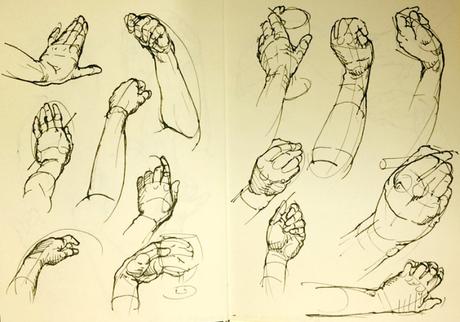
I make tonal decisions—how closely to group my dark tones, while preserving a logical gradation; separating shadows from halftones so I can meaningfully describe the way light plays over the surfaces. I consider the gamut of colours available to me in my paint choices—how a cadmium yellow and a pale rose red can stretch it further than a yellow ochre and a deep transparent red. I know that no matter what, paint does not have the reach of light, and it is not possible to match the full range that I see. So I establish my limits, reserving the highest chroma available to me for where I most need it, and correspondingly dulling the rest. I impose a logical system of neutralising color with the falloff of light, conceptualising the relationships between colours as a three-dimensional space that I can move through with increasing fluency. When I vary yellow, I factor in the way purple neutralises it, and what that would mean in my picture, and I consider the ‘vertical’ shift I want to make in tone and in chroma as I transition from one color to another.
I think about the brush in my hand, how stiff or springy its bristles are, how splayed, how neat and flexible, and I invoke textures by the movement of my hand. Those textures hang in relation to one another, I must reserve certain techniques for smooth objects compared to coarse ones. And everything must fit into the system dictated by the quality of the light: whether it is diffuse, gray natural light, or blue unclouded daylight, or orange-yellow artificial light, or something else. ‘Every artist has to know and construct a schema before he can adjust it to the needs of portrayal,’ Gombrich (1959: 99) is right to insist. And my schema, derived from many places, but notably not from photography, is reasonably sophisticated.
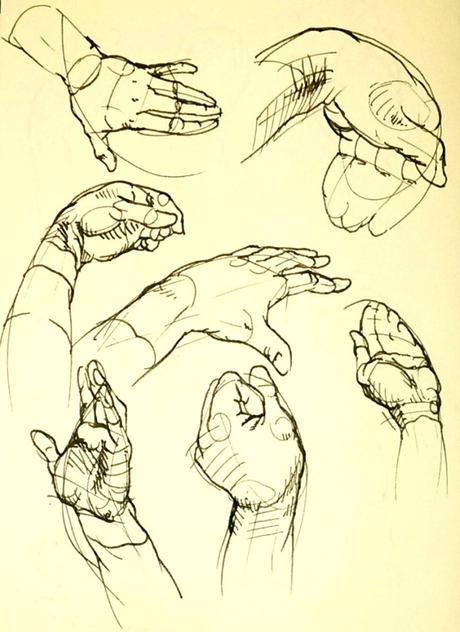
Painting the ever-shifting natural world demands visual acuity, but also a mental acuity. For as painters, we do not merely observe and transcribe, but we organize what we see. When we paint, we establish relationships, and the character of those relationships—of light to dark, of vividness to neutrality, of smoothness to coarseness to softness to brittleness—directs the quality of the painting. Painting is not, as Gombrich (1959: 78) argues, ‘a faithful record of a visual experience but the faithful construction of a relational model.’ All painters construct relational models; it is only a question of what the model is based on, and how well the painter understands that model.

And the crucial point is whether a painter is passive or active. Because an artist worthy of our attention and respect does not work mindlessly, or randomly, or uncritically. She tests every new observation, and wrestles with it until she finds a way to work it into her system. She pushes her system to do more and more, to cope with greater ambiguity, to suggest more with less, to reflect the shimmering richness of the natural world. To do that, she will probably have to move away from the sufficient but sorely limited laws of the lens, to embrace the sticky willfulness of paint and to try to subdue the chaos in new ways, even if they are unsuccessful at first. ‘[The artist] is the man who has learned to look critically, to probe his perceptions by trying alternative interpretations both in play and in earnest,’ (Gombrich 1969: 265).
My paintings are a head-on struggle between what I see and the beautifully restricted medium in which I work. They document the hard-won schemata that I continue to grow as I bounce between the natural world and the teachings of other artists living and dead. ‘Naturalism’ in painting should never be fettered to the camera, for photography is only another means of representation, with other limits that painting can be blissfully free of. We are mistaken to find a painting more ‘realistic’ the more its relationships match those we are familiar with through photography, because, as Gombrich (1959: 75) puts it, ‘there is no neutral naturalism.’ Paint offers so many subtle and lively possibilities that approach the rich and nuanced experience of sight in ways that photography never will.
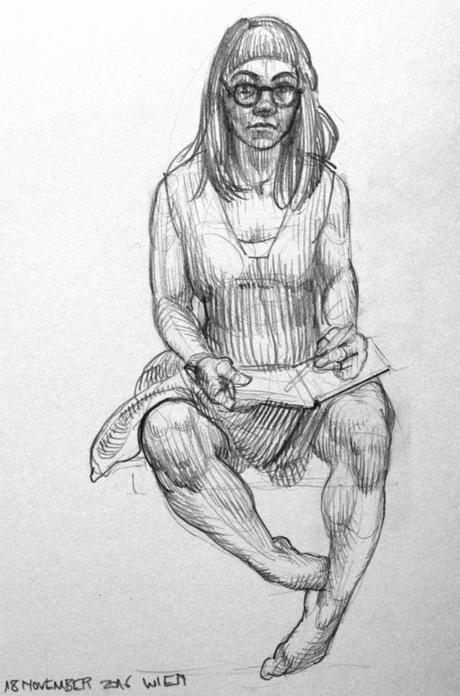
Gombrich, E. H. 1959. Art and Illusion. Phaidon: London.

